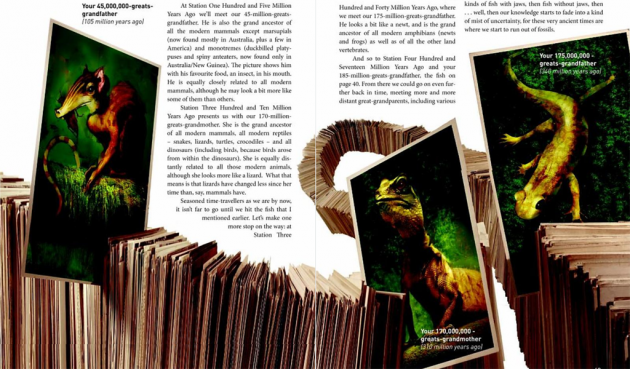Magic of Reality by Richard Dawkins
Magic of Reality is the first book of Richard Dawkins which is written for early teenage readers. With the help of Dave McKean's illustrations it is probably one of the best books for young inquiring minds. That's great because exactly this populace is quite susceptible to adult gibberish from religious zealots, conspiracy theorists or new agers alike.
The book has 12 chapters, and each starts with a question. Before the scientific explanation, Dawkins has found a couple of myths which were used to explain the conundrum in ancient times. Unfortunately, some are still used today as religious truths.
Although this book isn't intended for grown ups as such, they may nevertheless find interesting a myth or two, or great analogy for explaining something, or even learn something new, like extra solar planet detection. So it would be prudent for them to secretly read through it before giving it to their nephew as a gift, or read it while their child is interested in some other activity.

Dave McKean's illustrations, though pretty in their own right, really do add value to the topics discussed!
I've read paper edition of the book, but the iPad version of the book is available as well.
Here is brief description of the contents through chapters:
1. What is reality? What is Magic?
In his characteristic way, Richard begins by defining word „Reality“. Older readers of his books will quite easily recognize this as safeguarding against misinterpretations.
This chapter enchants, pun intended, the young reader to the educational travel ahead.
2. Who was the first person?
3. Why are there so many different kinds of animaly?
Being evolutionary biologist it seems fitting that he starts with evolution and natural selection. This are, arguably, the best gems in the book, in which he, through picturesque analogies, clearly describes these topics to the reader.
4. What are things made of?
Richard then jump into physics and chemistry, explaining atoms and molecules, the building blocks of everything we see around us.
5. Why do we have night and day, winter and summer?
6. What is the sun?
Delving into the astronomy, he describes our planet, its motions and gravity in general. In the next chapter he describes our local star, stars life, and it's importance for life.
7. What is rainbow?
Is a return to the world of physics, describing nature of rainbow, and through it, electromagnetic spectrum.
8. When and how did everything begin?
Although it seems that previous chapter broke astronomy theme, it was a needed detour for better explaining the origin of universe. Dawkins explains how we measure space distances (though spectroscopy), space velocities (using Doppler shift) and thus how that leads to the Big Bang Theory.
9. Are we alone?
This chapter explains in an interesting way possibility of life outside of Earth. Touching on that theme, he describes how myths (in this case modern ones) begin.
10. What is an earthquake?
Great catastrophes are often used by uneducated people as a proof of higher power. The power of earthquakes is immense, but it's origin is not in whims of personificatied gods, but in the Earth's depth.
11. Why do bad things happen?
12. What is a miracle?
Though the book has limited space to explain everything, concluding chapters give the young reader a tool for tackling everything mysterious through critical thinking. Interestingly, Dawkins doesn't use Occam's razor, but a version of it by David Hume.